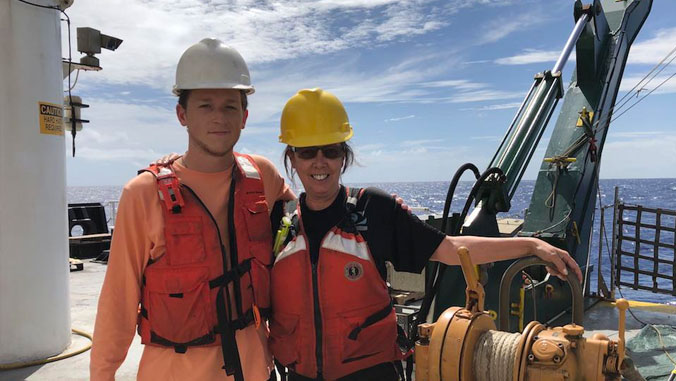Ten motivated undergraduate students arrived at the University of Hawaiʻi at Mānoa to participate in a summer research internship, Earth Science on Volcanic Islands, hosted by the Department of Earth Sciences. The program, funded for three years by the National Science Foundation’s Research Experience for Undergraduates (REU), seeks to increase participation in the STEM (science, technology, engineering and math) workforce by underrepresented groups.
The internship program takes advantage of the unique tropical volcanic islands and surrounding marine environments in Hawaiʻi. Led by School of Ocean and Earth Science and Technology (SOEST) earth sciences faculty, the cohort departed on a three-day expedition on the UH Mānoa research vessel Kilo Moana to a previously unsampled submarine volcanic rift zone located west of Kahoʻolawe.
The current geologic map for Kahoʻolawe is largely based on a map drafted in 1940. At present, only 14 rock samples from there have been age-dated, and about 50 have been analyzed for rock type and chemistry. A primary goal of this student-focused research cruise was to collect a broad range of rock samples from the nearby seafloor to improve data on rock chemistry, volcanic history and age estimates of this rift zone and enhance understanding of how the area is related geologically to Kahoʻolawe and Maui.
A research-filled summer
For the remainder of the nine-week internship, students are assigned to work with faculty throughout SOEST, with mentors from earth sciences and oceanography departments as well as the Hawaiʻi Institute for Geophysics and Planetology and botany department.
Participants will conduct a wide range of original research, including studies of active and inactive Hawaiian volcanoes, environmental science in tropical watersheds and coastal environments, effect of groundwater discharge on corals, and mapping and modeling of earth processes.
“The goal of our program is to find highly qualified students for whom participation in this program will have the biggest impact, and provide them with cutting-edge earth science research opportunities in Hawaiʻi,” said Paul Wessel, program director and chair of the Department of Earth Sciences in SOEST. “These 10 students were selected from a large pool of over 300 applicants, and represent a vibrant and diverse cohort of undergraduate students from across the country. They make up a smart and hard-working group that is very excited to be spending the summer in Hawaiʻi.”
Said REU intern Kayli Ching, a Kapiʻolani Community College student, “One of the fields I’m considering getting into is biological oceanography, and oceanographers go out to sea a lot. So this trip was really nice to give me a feel for what I would like or wouldn’t like on a cruise and, so far, I like just about everything.”
See the full story on the SOEST website.
—By Marcie Grabowski


